Leather subculture

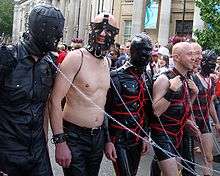
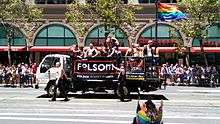
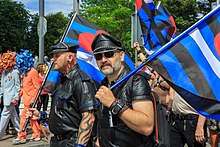
The leather subculture denotes practices and styles of dress organized around sexual activities that involve leather garments, such as leather jackets, vests, boots, chaps, harnesses, or other items. Wearing leather garments is one way that participants in this culture self-consciously distinguish themselves from mainstream sexual cultures. Many people associate leather culture with BDSM (Bondage/Discipline, Dominance/Submission, Sado/Masochism, also called "SM" or "S&M") practices and its many subcultures. But for others, wearing black leather clothing is an erotic fashion that expresses heightened masculinity or the appropriation of sexual power; love of motorcycles, motorcycle clubs and independence; and/or engagement in sexual kink or leather fetishism.[1]
History
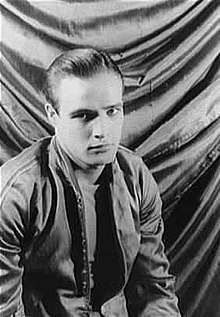
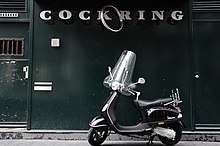
Male leather culture has existed since the late 1940s,[1] when it likely grew out of post-WWII biker culture. Early leather bars were subcultural versions of the motorcycle club with pioneering motorcycle clubs including the Satyrs, established in Los Angeles in 1954; Oedipus, also established in Los Angeles in 1958, and the New York Motorbike Club. Early San Francisco clubs included the Warlocks and the California Motor Club,[2] while early clubs in Sydney included the South Pacific Motor Club (SPMC). The first gay leather bar, the Gold Coast, opened in Chicago in 1958. Leather Clubs started in Amsterdam and Berlin in the 1950s, and in Sydney from 1970.
These clubs, like the clubs of motorcycle culture in general, reflected a disaffection with the mainstream culture of post-World War II America, a disaffection whose notoriety — and therefore appeal — expanded after the sensationalized news coverage of the Hollister "riot" of 1947. The 1953 film The Wild One, starring Marlon Brando wearing jeans, a T-shirt, a leather jacket, and Muir cap, played on pop-cultural fascination with the Hollister "riot" and promoted an image of masculine independence that resonated with some men who were dissatisfied with mainstream culture. Also, motorcycle culture also reflected some gay men's disaffection with the gay cultures more organized around high culture, popular culture (especially musical theater), and/or camp style. As well, the leather community that emerged from the motorcycle clubs also became the practical and symbolic location for men's open exploration of kink and S&M.[2]
Aspects of leather culture beyond the sartorial can be seen in the 1970 murder mystery novel Cruising by Jay Green. The novel was the basis for the 1980 movie Cruising, which depicted aspects of the men's leather subculture for a wider audience.
In the 1970s Berlin had a huge leather scene with several leather clubs in the area around Nollendorfplatz. The pornographic films of one of Tom of Finland's models Peter Berlin from Berlin, such as his 1973 film Nights in Black Leather, also reflected and promoted the leather subcultural aesthetic. In 1975 Europe's biggest fetish event started, Easter in Berlin Leather Festival. Also in Europe younger men combined the aesthetic and exploration of sexual power with the gay skinhead movement and social-fraternal organizations like BLUF, from the late 1970s.
Distinct aspects of heavy metal fashion can be credited to various bands, but the band that takes the most credit for revolutionizing the look was Judas Priest, primarily with its singer, Rob Halford, who openly identifies as gay and wears black leather.[3] Halford wore a leather costume on stage as early as 1978 to coincide with the promotion for the Killing Machine (Hell Bent for Leather in the United States) album.
Also in 1978, Pat Califia, who identified as a lesbian at the time, co-founded Samois, a lesbian-feminist BDSM organization in San Francisco that existed from 1978 to 1983 and was the first lesbian BDSM group in the United States. (More under "Lesbian" below)[4]
In recent decades the leather community has been considered a subset of BDSM culture rather than a descendant of gay culture. Even so, the most visibly organized SM community has been a subculture, as evidenced by the American competition known as 'International Mr. Leather' (established 1979), and SM in the UK (established 1981). International Ms. Leather was first held in 1987.[5][6]
In 1984, the Folsom Street Fair in San Francisco was held for the first time, the world's largest leather event and showcase for BDSM products and culture.[7]
The leather pride flag was designed by Tony DeBlase (who lived 1942-2000). He first presented the design at the International Mister Leather event in Chicago, Illinois, U.S. on 28 May 1989.[8]
Initial reaction to the flag was mixed. According to DeBlase's article A Leather Pride Flag,
"Some, particularly on the east coast, reacted positively to the concept, but were quite concerned, some even offended, that I had not involved the community in helping to create the design."[9]
In June of 1989 the flag was used by the leather contingent in a Portland, Oregon pride parade, which was its first appearance at a pride parade.[10]
In 2005 Viola Johnson started The Carter-Johnson Leather Library, "a non-profit [501(c)(3) pending] organization that consists of a traveling collection of thousands of books, magazines, posters, art, club and event pins, newspapers, event programs and ephemera showing leather, fetish, S/M erotic history."[11][12]
The LGBTQ and Leather Cultural District was created in South of Market, San Francisco in 2018.[13] It includes the San Francisco South of Market Leather History Alley, with four works of art, which opened in 2017: [14][15]
Traditions
Throughout the history of the leather subculture, a variety of traditions have been observed, often diligently.[16] While most or all are based on military protocols and ritual, these traditions varied widely between regions, causing much debate today over which traditions are the original or true traditions, or whether the "romanticized versions of leather history" ever existed at all.[17]
As time has progressed and BDSM has become more mainstream (see below), the traditions of leather have adapted. The first major evolution has become known as "New Leather" or "New Guard". However, even this is the subject of some disagreement, as many noted authors and historians assert that there are little or no substantive differences.[18][19]
Today, the leather subculture is one of many facets to semi-organized alternative sexuality. Many individuals describe long periods of introspection leading to their choice to identify as "leather".[20] Others do not necessarily associate their leather lifestyle with BDSM, and simply enjoy the sensory experience of leather.[21]
Representations
The more specifically homoerotic aesthetics of men's leather culture drew on other sources as well, including military and police uniforms. This influence is particularly evident in the graphical illustrations of leathermen found in the work of Tom of Finland. The pornographic films of one of his models Peter Berlin from Berlin, such as his 1973 film Nights in Black Leather, also reflected and promoted the leather subcultural aesthetic. In the 1970s Berlin had a huge leather scene with several leather clubs in the area around Nollendorfplatz. In 1975 Europe's biggest fetish event started, Easter in Berlin Leather Festival.
Aspects of leather culture beyond the sartorial can also be seen in the 1970 murder mystery novel Cruising by Jay Green. The novel was the basis for the 1980 movie Cruising, which depicted aspects of the men's leather subculture for a wider audience.
Distinct aspects of heavy metal fashion can be credited to various bands, but the band that takes the most credit for revolutionizing the look was Judas Priest, primarily with its singer, Rob Halford, who openly identifies as gay and wears black leather.[3] Halford wore a leather costume on stage as early as 1978 to coincide with the promotion for the Killing Machine (Hell Bent for Leather in the United States) album. In a 1998 interview, Halford described the leather subculture as the inspiration for this look. Shortly after appropriating the leather look, Halford started appearing onstage on a roaring motor bike. Soon, the rest of the band followed.
Subcultures
Today, while some may still use the term strictly in the old-fashioned sense (i.e., the romanticized Old Guard), more than ever the leather subculture in the 21st century represents the activities of several major sub-communities.[1] These include BDSM practitioners, and people who have a preference for aggressive or masculine sexual styles; people who love motorcycles; people involved in kink or leather fetishism; and people who participate in large-scale cultural and marketing events such as Folsom Street Fair or leather-themed circuit parties.
Lesbian
Although gay men are the most visible symbol of the leather community, there are numerous women who identify as leatherwomen - and women have the International Ms. Leather (IMsL) event as their corollary to International Mr. Leather (IML). An example is Joan Jett, who has a leather pride sticker prominently displayed on her guitar.
Relatively few lesbian women were visible during the early emergence of the leather subculture. Pat Califia, who identified as a lesbian at the time, was an activist in the San Francisco leather subculture, and is credited for defining the emergence of lesbian leather subculture. In 1978, Califia co-founded Samois, a lesbian-feminist BDSM organization in San Francisco that existed from 1978 to 1983 and was the first lesbian BDSM group in the United States.[4] CCalifia was an activist in the San Francisco leather subculture, is credited for defining the emergence of lesbian leather subculture, and became a prolific contributor to lesbian and BDSM literary erotica and sex guides. Califia now identifies as a bisexual transgender man.
Lesbian BDSM groups emerged in Sydney, Los Angeles and New York in the early 1980s. Groups such as G.O.D. and Wicked Women in Sydney began presenting events and publishing magazines and books.
Leather and Lace, a woman's BDSM support and social group, was founded in Los Angeles in 1980. The women of Leather and Lace learned the "old guard" traditions from the men of Avatar. Leather and Lace had a code of conduct, a uniform that could only be worn once a member earned the right. In New York, there was LSM. Only members of the club were allowed to know that LSM stood for Lesbian Sex Mafia.
By age groups
In the United States men's leather culture has been associated with men above the age of 40 but recent years have seen growing numbers of younger leather men; and in much of the rest of the world, including Europe and Australia, there is a merging of the established older leather community with young leathermen and leatherwomen and kink/fetish/gear communities. In Europe younger men have combined the aesthetic and exploration of sexual power with the gay skinhead movement and social-fraternal organizations like BLUF, from the late 1970s.
Places and Events
Events
The Folsom Street Fair, begun in 1984, is an annual BDSM and leather subculture street fair held in September, that caps San Francisco's "Leather Pride Week". The Folsom Street Fair, sometimes simply referred to as "Folsom", takes place on Folsom Street between 8th and 13th Streets, in San Francisco's South of Market district. The event is California's third-largest single-day, outdoor spectator event and the world's largest leather event and showcase for BDSM products and culture.[22] Folsom Street Events now organizes many events each year[23] including Folsom Europe.
Other large events include Easter in Berlin (the largest leather event in Europe), International Mr. Leather and Mister Leather Europe, and Amsterdam Leather Pride (see Wikipedia article in Dutch).</ref> Other large events include Easter in Berlin (the largest leather event in Europe), International Mr. Leather and Mister Leather Europe, and Amsterdam Leather Pride (see Wikipedia article in Dutch).
Archives
Many LGBT museums, archives and libraries collect material relating to leather communities, with many holdings substantial collections, including the Australian Lesbian and Gay Archives and the dedicated Leather Archives and Museum, based in Chicago. The Leather Archives and Museum is dedicated to compilation, preservation, and maintenance of leather, kink, and fetish lifestyles. The museum galleries serve to present educational and historical material to an adult audience.[24] In 2005 Viola Johnson started The Carter-Johnson Leather Library, "a non-profit [501(c)(3) pending] organization that consists of a traveling collection of thousands of books, magazines, posters, art, club and event pins, newspapers, event programs and ephemera showing leather, fetish, S/M erotic history."[11][12]
Cultural districts
The LGBTQ and Leather Cultural District was created in the South of Market (SoMa) neighborhood of San Francisco in 2018.[25] It includes the San Francisco South of Market Leather History Alley, with four works of art, which opened in 2017: [14][15] the four works of art are: A black granite stone etched with a narrative by Gayle Rubin, an image of the "Leather David" statue by Mike Caffee, and a reproduction of Chuck Arnett’s mural in a former leather bar, engraved standing stones that honor community leather institutions (one being the Folsom Street Fair), leather pride flag pavement markings through which the stones emerge, and metal bootprints along the curb which honor 28 people who were an important part of the leather communities of San Francisco.[15][14]
Bars and urban districts
Many major cities around the world had or have legendary leather bars and clubs, and in some cases a concentration of these associated a particular district with the leather scene:
- Amsterdam: the Cockring and Eagle bars and Warmoesstraat street — noting the closing of most of the leather bars once here, newspaper Het Parool stated in 2015 that "the darkroom has been consigned to history because of Grindr"[26]
- Berlin: Tom's Bar and the area around Nollendorfplatz
- New York City: the Mineshaft bar and the Meatpacking District[27]
- San Francisco: the LGBTQ and Leather Cultural District covers the area which traditionally has had a concentration of leather bars and clubs
See also
External links
References
- 1 2 3 "Elegy for the Valley of Kings," by Gayle Rubin, in In Changing Times: Gay Men and Lesbians Encounter HIV/AIDS, ed. Levine et al., University of Chicago Press
- 1 2 Rubin, Gayle. "The Miracle Mile: South of Market and Leather, 1962-1997" in Reclaiming San Francisco: History, Politics, Culture (City Light Books, 1998)
- 1 2 Heavy Metal: The Music and Its Culture - Deena Weinstein - Google Boeken. Books.google.com. Retrieved 18 May 2014.
- 1 2 Jeffreys, Sheila (1993). The Lesbian Heresy. North Melbourne, Vic., Australia: Spinifex. p. 130. ISBN 978-1-875559-17-6.
- ↑ In Changing Times: Gay Men and Lesbians Encounter HIV/AIDS. p. 126. ISBN 9780226278568.
- ↑ Rubin, Gayle S. (1994). The valley of the kings: leathermen in San Francisco, 1960-1990, Volume 2. University of Michigan. p. 419.
- ↑ "Cheap date - what to do?". Cnn.com.
- ↑ "Leather History Timeline". Archived from the original on 2010-08-03. Retrieved 2008-02-14.
- ↑ "A Leather Pride Flag". leatherarchives.com. Archived from the original on 2008-09-15.
- ↑ "Timeline". Web.archive.org. Archived from the original on 2010-08-03. Retrieved 2018-06-24.
- 1 2 "Carter/Johnson Leather Library". Leatherlibrary.org. Retrieved 18 May 2014.
- 1 2 "Carter/Johnson Leather Library". www.leatherlibrary.org.
- ↑ Sabatini, Joshua (2018). "SF expands cultural districts to include SoMa's gay and leather community - by j_sabatini - May 1, 2018 - The San Francisco Examiner". Sfexaminer.com. Retrieved 2018-05-02.
- 1 2 3 http://www.artandarchitecture-sf.com/ringold-alleys-leather-memoir.html
- 1 2 3 Paull, Laura. "Honoring gay leather culture with art installation in SoMa alleyway – J". Jweekly.com. Retrieved 2018-06-23.
- ↑ Guy Baldwin (1993). "THE OLD GUARD (The History of Leather Traditions)". Ties that Bind. Archived from the original on 5 January 2010. Retrieved 27 October 2010.
- ↑ Jay Wiseman. "An Essay About "the Old Days"". Submissive Women Kvetch. Retrieved 27 October 2010.
- ↑ Jack Rinella. "The Myth of the Old Guard". LeatherViews. Retrieved 27 October 2010.
- ↑ Gayle Rubin. "Old Guard, New Guard". Cuir Underground. Retrieved 27 October 2010.
- ↑ Cross (2010). "Finding Leather". Cross Culture BDSM. Retrieved 27 October 2010.
- ↑ "What Does Wearing Leather Mean? Markup". Long Island Ravens MC. Archived from the original on 27 July 2011.
- ↑ "Cheap date - what to do?". Cnn.com.
- ↑ https://www.folsomstreetevents.org/
- ↑ "Home page of the Leather Archives & Museum". www.leatherarchives.org. Retrieved 2016-05-07.
- ↑ Sabatini, Joshua (2018). "SF expands cultural districts to include SoMa's gay and leather community - by j_sabatini - May 1, 2018 - The San Francisco Examiner". Sfexaminer.com. Retrieved 2018-05-02.
- ↑ https://www.parool.nl/amsterdam/darkroom-wordt-herinnering-aan-vorige-eeuw-door-grindr~a3827356/
- ↑ http://nymag.com/nightlife/features/gay-bar-history-2013-1/
| Wikimedia Commons has media related to Leather subculture. |
